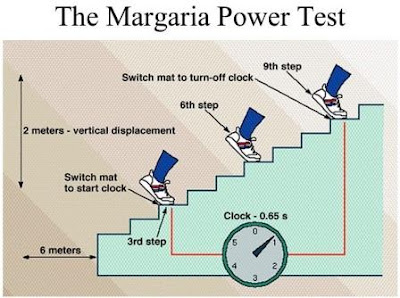Margaria-Kalamen Power Test. Measure physical fitness component can do by performance test. Power is one piece of physical fitness component that can be measure by test. One of power test is margaria-kalamen power test. The purpose of this test is to measure the development of the athlete's power. This test can do for athlete that power was needed when perform in competition.
Required resources
To undertake this test you will require:
• Stop watch
• Assistant
• Flight of 12 steps with a starting line of 6m in front of the first step – each step is about 17.5cm high with the 3rd, 6th and 9th step brightly coloured.

How to conduct the test
The test is conducted as follows:
• The athlete’s weight is determined (kg) and recorded
• The athlete undertakes 2 or 3 practice runs up the steps to warm up
• The athlete stands ready at the starting line
• On the command "Go", the athlete sprints to the steps and up the flight of steps taking three steps at a time (3rd, 6th and 9th stairs).
• Assistant records the time to get from the 3rd step to the 9th step – the stopwatch is to be started with foot contact on the 3rd step and stopped with foot contact on the 9th step
• Athlete repeats the test 2 more times – allow a 2-3 minute recovery between each test.
Analysis
Analysis of the result is by comparing it with the results of previous tests. It is expected that, with appropriate training between each test, the analysis would indicate an improvement.
Power (Watts) is calculated from the formula: P = (M x D) * 9.8/t where
• P = Power (Watts)
• M = Body mass (kg)
• D = Vertical distance (m)
• t = Time (s).
The vertical distance between the 3rd and 9th step must be accurately measured and used when calculating the power.
Target group
This test is suitable for active athletes but not for individuals where the test would be contraindicated.
Reliability
Reliability would depend upon how strict the test is conducted and the individual's level of motivation to perform the test.
Validity
There are no published tables to relate results to potential performance in competition.
Reference: Brian Mackenzie, 2005. 101 Performance Evaluation Test
